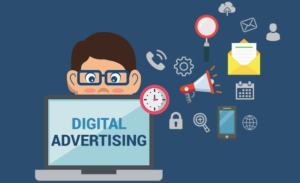The Evolution and Impact of Digital Advertising

Digital advertising has revolutionized the way businesses reach and engage with their audiences. Unlike traditional advertising methods, digital advertising offers precise targeting, measurable results, and dynamic content delivery, making it an essential component of modern marketing strategies. This article explores the evolution, types, benefits, and future trends of digital advertising.
Digital advertising has come a long way since its inception in the early 1990s. The first banner ad appeared on the web in 1994, sparking a new era of online marketing. Over the years, advancements in technology and the proliferation of internet usage have significantly transformed the digital advertising landscape.
1. Early Days (1990s):The era of simple banner ads and pop-ups began, with limited targeting and measurement capabilities.
2. Search Engine Advertising (2000s): The rise of search engines like Google introduced pay-per-click (PPC) advertising, enabling advertisers to bid on keywords and reach users based on their search queries.
3. Social Media Advertising (2010s): Platforms like Facebook, Twitter, and Instagram provided new avenues for highly targeted and interactive ads.
4. Programmatic Advertising (Mid-2010s): Automated, real-time bidding for ad inventory became widespread, increasing efficiency and precision in ad placements.
Types of Digital Advertising
Digital advertising encompasses a variety of formats and channels, each with its own strengths and use cases. Here are some of the most popular types:
1. Search Engine Advertising (PPC):
– Google Ads: Advertisers bid on keywords to display ads in search engine results.
– Bing Ads: Similar to Google Ads, but on Microsoft’s search engine.
2. Display Advertising:
– Banner Ads: Visual ads displayed on websites, often in the form of images or interactive media.
– Rich Media Ads: Interactive ads that include elements like video, audio, or other engaging features.
3. Social Media Advertising:
– Facebook Ads: Targeted ads based on user demographics, interests, and behaviors.
– Instagram Ads: Visually-driven ads ideal for brand awareness and engagement.
– Twitter Ads: Promoted tweets and accounts to reach a broader audience.
– LinkedIn Ads: Professional networking ads targeting specific industries or job titles.
4. Video Advertising:
– YouTube Ads: Video ads that appear before, during, or after YouTube videos.
– In-Stream Ads: Ads within video content on various platforms.
5. Native Advertising:
– Sponsored Content: Ads designed to match the look and feel of the platform on which they appear, such as sponsored articles or posts.
6. Affiliate Marketing:
– Commission-Based Ads: Businesses pay affiliates for driving traffic or sales through their promotional efforts.
7. Email Advertising:
– Sponsored Emails: Advertisements included within email newsletters or campaigns.
Benefits of Digital Advertising
Digital advertising offers numerous advantages over traditional advertising methods:
1. Precise Targeting: Advertisers can reach specific audiences based on demographics, interests, behaviors, and location.
2. Measurable Results: Advanced analytics provide detailed insights into campaign performance, including impressions, clicks, conversions, and ROI.
3. Cost-Effective: Digital ads often provide a higher return on investment (ROI) due to their precise targeting and lower costs compared to traditional media.
4. Flexibility and Scalability: Campaigns can be easily adjusted and scaled up or down based on performance and budget.
5. Engagement: Interactive ad formats foster higher engagement rates and deeper connections with audiences.
Future Trends in Digital Advertising
As technology continues to evolve, several trends are shaping the future of digital advertising:
1. Artificial Intelligence (AI) and Machine Learning: These technologies enhance ad targeting, personalization, and predictive analytics.
2. Voice Search Optimization: As voice-activated devices become more prevalent, optimizing ads for voice search will be crucial.
3. Augmented Reality (AR) and Virtual Reality (VR): Immersive ad experiences that engage users in new and exciting ways.
4. Privacy and Data Protection: With increasing concerns over data privacy, advertisers must navigate regulations like GDPR and CCPA while maintaining effective targeting.
5. Programmatic Advertising: Continued advancements in programmatic buying will lead to more efficient and effective ad placements.
Conclusion
Digital advertising has transformed the marketing landscape, offering unparalleled targeting, engagement, and measurement capabilities. By leveraging the various types of digital ads and staying abreast of emerging trends, businesses can effectively reach their audiences, drive growth, and achieve their marketing objectives. As technology and consumer behavior continue to evolve, digital advertising will remain a dynamic and essential component of any successful marketing strategy.


